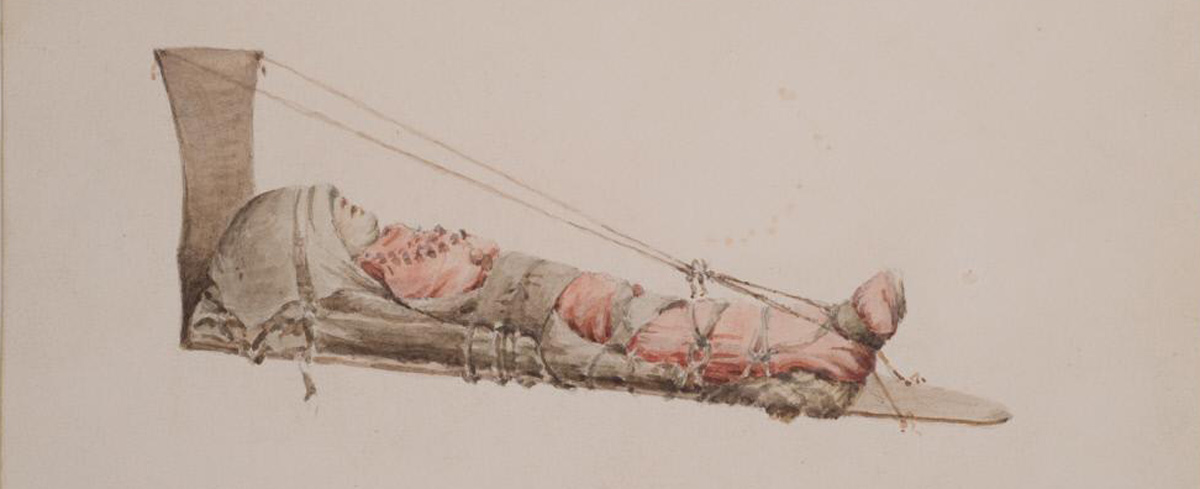Sgt. Gass notices visitors with flattened heads, and the captains compare languages and customs of the Sahaptin and Chinookan Peoples living above and below The Dalles of the Columbia. One group is prevented from handling the goods left out to dry, and they leave in a bad humor.
Trade Goods Out to Dry
by Yellowstone Public Radio[1]Originally aired weekdays by Yellowstone Public Radio during the Bicentennial observance of 2003-2006. Narrated by Hal Hansen. Scripts by Whit Hansen and Ed Jacobson. Produced by Leni Holliman. © … Continue reading
“Child in the Process of Having Its Head Flattened”
Paul Kane (1810-1871)
Watercolor on paper, Height: 12.4 cm, Width: 17.8 cm. Scanned from Eaton, D.; Urbanek, S.: Paul Kane’s Great Nor-West, University of British Columbia Press; Vancouver, 1995.
Kane painted this Cowlitz baby while visiting Cowlitz Farm of the Hudson’s Bay Company. For more of his description, see “Kane’s Observations” in Chinookan Head Flattening.
Chinookan Head Flattening
We suppose them to be a band of the Flathead nation, as all their heads are compressed into the same form . . . . This singular and deforming operation is performed in infancy
—Patrick Gass
Sahaptin and Chinookan Peoples
we took a Vocabelary of the Languages of those two chiefs which are verry different notwithstanding they are Situated within Six miles of each other, Those at the great falls Call themslves E-nee-shur and are understood on the river above: Those at the Great Narrows Call themseles E-che-lute and is understood below
—William Clark
A Bad Humor
The two Chiefs & party was joined by Seven others from below in two canoes, we gave them to eate & Smoke Several of those from below returned down the river in a bad humer, haveing got into this pet by being prevented doeing as they wished with our articles which was then exposed to dry—
—William Clark
Columbian Black-tailed Deer
Odocoileus hemionus columbianus
© 8 November 2008 by Kristopher K. Townsend. Permission to use granted under the Creative Commons Attribution-Share Alike 4.0 International license.
Good Hunting
Wind hard from the west all the last night and this morning. Some words with Shabono our interpreter about his duty. Sent out Several hunters who brought in four Deer, one Grouse & a Squirel.
—William Clark
Weather Diary
Day of the month Wind State of the Weather 27th W. fair Note from the 22d to the 29th about the Great Falls [Celilo Falls] of the Columbia river.
—William Clark[2]Some abbreviations have been spelled out.
Experience the Lewis and Clark Trail
The Lewis and Clark Trail Experience—our sister site at lewisandclark.travel—connects the world to people and places on the Lewis and Clark Trail.
Plan a trip related to October 27, 1805:

Rock Fort Campsite is a High Potential Historic Site along the Lewis and Clark National Historic Trail managed by the U.S. National Park Service. The site owned by Wasco County, Oregon, and is open to the public.
Notes
| ↑1 | Originally aired weekdays by Yellowstone Public Radio during the Bicentennial observance of 2003-2006. Narrated by Hal Hansen. Scripts by Whit Hansen and Ed Jacobson. Produced by Leni Holliman. © 2003 by Yellowstone Public Radio. |
|---|---|
| ↑2 | Some abbreviations have been spelled out. |




